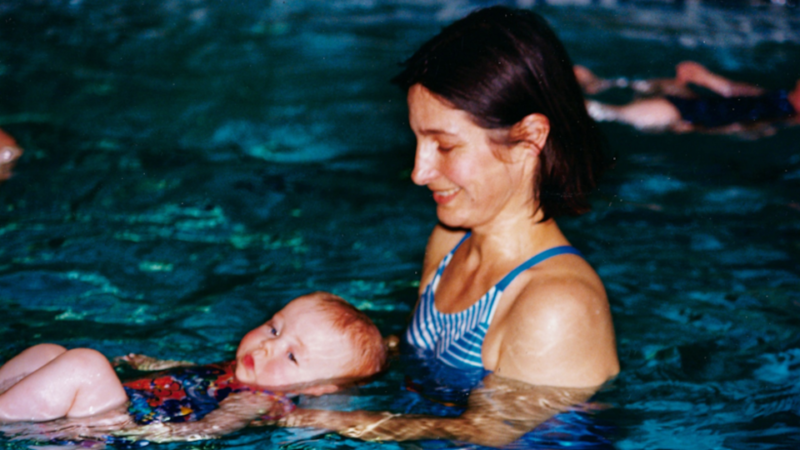
Early Days
My baby-swimming journey started with the birth of my eldest daughter in 1975. I had some time between her birth and returning with her to my work in the Amazon. I needed to get her used to being in the water, crossing rivers with me and playing in the shallows with older children. I experimented with introducing her to water in our filled home bath aged three days: it did not work out. Then, I was reprimanded for swimming laps in backstroke in the fast lane with her on my front aged two weeks in the city pool. I am lucky not to have been sectioned. We continued our ‘water play’ in less public places. I never felt unsafe or threatening her safety.
Progress in the Amazon
Baby and toddler swimming have now reached a peak of popularity as a foundation for swimming that it is near impossible to imagine mainstream views and methods for teaching children how to swim then. Everywhere I turned, I got the same answer that there is no point trying before children’s fifth birthday. Luckily Miss Haddock, a Cambridge swimming teacher, offered to support me in securing my daughter’s swimming skills before we left for another long stay in the Amazon, when she was three. This time it was essential that she could swim confidently. I ordered an infant’s life jacket from Canada (a new concept) but I already knew that she would not be happy to wear this bright orange piece of kit when playing in water with local kids. By the time we left, she had basic water skills, that is, she could swim along the pool edge with a pole dangling in front of her. Hi 5! Her skills truly built up during another great year in the Amazon, with lots of ‘messing about in the river’ as people do daily. ‘Our’ river ran quite fast but there were safe shallows for women to wash clothes and children to play-swim. Small children help mums to catch armoured fish, crayfish, and other delicious water creatures, so diving is an early skill. There was always someone watching, and all activities were collective, with children helping younger ones.
Further Experience
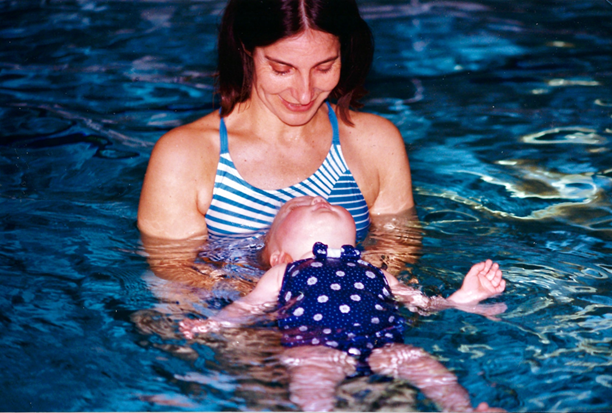
I felt ready to welcome a small group of parents and babies to develop a gentle approach to water parenting
Back in the UK, I was attracted by the Russian pioneer Tjarkovsky’s passion for water and babies in water. But the freedom of swimming toddlers pictured in books and films about his method came at the cost of violent conditioning that seemed terribly wrong to me as a mother and as a person. It was contrary to our Amazon playful and relaxed experience. After my second daughter was born, I set out to achieve the same results in the UK, reproducing what I had lived and observed with her sister. After further experimenting with my two sons, who both swam early but with a completely different way of ‘surfacing to breathe’, I felt ready to welcome a small group of parents and babies to develop a gentle approach to water parenting, laying foundations of swimming. 1992 marked the transition to classes where parents were taught techniques while still having lots of fun. We continued to have family sessions with siblings of different ages.
Coming Full Circle
In 2022, 30 years later, I feel we have come full circle after ‘baby swimming’ was developed as a thriving industry, with stereotyped one-fit-all type classes arranged in distinct age groups and mandatory practices. Sadly, these early water activities, that are often expensive, rarely lead to confident swimming skills. At age 4-5, or as part of school activities children join swimming-teaching classes in which there is little time for individual attention. In the aftermath of the Covid-19 lock down, a whole cohort of toddlers have missed out on early aquatic activities in pools. The time is right for a new start.
Early aquatic activities are well accepted in the global culture of parenting. We no longer need to fool parents with the illusion that their babies can ‘swim’ by showing them seductive underwater images. Everybody knows they are fake. But everybody also knows the health and development benefits of early aquatic activities, as demonstrated in research studies. Many parents love the special bonding experience that water allows with their babies. The right set of circumstances seem to be there to think again about the best formats that can give parents and babies together the best possible experience, while being financially viable for teachers and pool operators.
The First Baths
To me, water and feeling relaxed go together, and this starts with the first baby bath, the first entry in a warm pool. It has been a wonderful journey to discover that not only gentle methods work extremely well but also that they are best for enhancing the physical, mental and psychological development of babies. In the last two decades research in infant psychology and brain development has advanced at an unprecedented pace. We have access to a better understanding of how babies learn and grow and how different learning environments produce neuronal pathways that ‘shape’ babies’ brain configuration. The fast-developing research area of epigenetics probes deeper into the interface between inherited genetic traits and environment. The good news is that creating positive environments in which babies feel loved and nurtured has the potential to create cascades of long-ranging effects in children’s lives.
We can only ever teach when there is readiness, communication, and ease. Otherwise, we use forceful conditioning. Babies are very pliable, and we can bypass their resistance and screams through a process that infant psychologists call ‘habituation’. After repeated exposure to something that initially caused babies distress, they stop protesting and quietly submit in compliance. But this is DANGEROUS! By doing this, we have compromised communication, shutting off babies’ trust that we can perceive and understand their signals. We are going on a single sided journey of “do it my way, I am the adult, parent, teacher, the one with authority to make you feel competent or inadequate, so do it …” A lot of babies may not be affected; they might even emerge as stronger and performing better. They even learn to enjoy it because of loving to achieve or getting the rewards of pleasing parents and teacher. But the more sensitive babies may suffer adverse consequences in important ways that we are only just beginning to understand, at the roots of their self-esteem and ability to trust others, two foundations of human wellbeing and happiness.
The Need for Observation
To work with babies’ readiness, we need observation.
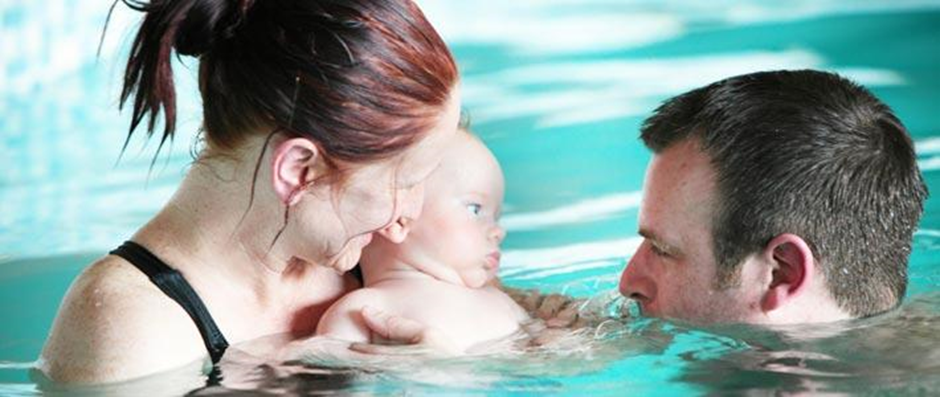
To work with babies’ readiness, we need observation. And because we are thrown at the deep end as parents (and baby swimming teachers) in experimenting with babies without a lot of previous experience with their kind, we need readiness ourselves to observe and respond appropriately to babies’ cues. AND, just as importantly, to parents’ cues. We really have three clients to look after: the baby, the parent, and the parent-baby pair as an interactive unit. Multiply this by 8! We are dealing with a crowd and need serious shortcuts to address all the different needs collectively –to create a happy learning environment- and individually, to offer individual attention and nurture. How is it possible to acquire such complex interpersonal sensitivity without years of teaching experience? At Birthlight, we have a passion for translating research findings into simple practices that help teachers in the water relate more directly, efficiently, and positively with parent-baby pairs. In 30 years, foundation practices have been developed, refined, and streamlined, but the early ways of teaching inspired by Amazonian indigenous people remain fully valid. In fact, some compromises and imported techniques included along the way can now be lifted. I am grateful to all the Birthlight tutors and teachers who have shared their knowledge, experience and wisdom along my baby swimming teaching journey, that I have never perceived as an individual one. There is a wonderful worldwide collective of pioneer seniors and younger teachers whose connections are strong and directed to a better future of ‘baby swimming’ as both aquatic early education and foundations of lifelong swimming.
Ideally, babies start their introduction to water before birth, feeling the relaxed aquanatal moves of their mums. But whatever the age of babies on their first water class, it is important for teachers to know how to assess which practices are going to work best for them. The understanding of cues, reflexes, body language, use of voice and word choice are all part of teachers’ equipment, just as important as the floating aids we may use.
Communication
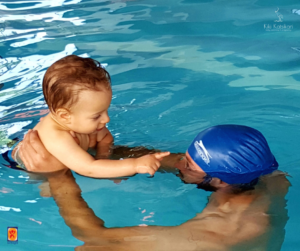
In all our practices, the element of communication is dominant: is the parent learning from the baby and responding to what the baby is trying to say? Rapidly, babies feel understood, beam to the parents and the parents start feeling on top of the world. We have then created an expanding spiral of enjoyable learning and a love of being together in water. Swimming is already programmed in the natural joy of free movement that infants experience. Submersion can be introduced in a relaxed way as part of flowing moves. The more spontaneously it is done as part of the supported confidence to move freely that babies have gained from ‘relaxed holds’ and their extensions in parents’ arms, the more babies find the self-propelling moves that can save lives if they fall in water. Rather than water-training babies by repeated submersions or sustained back-floating, we encourage them to move freely in the water, each in their own way and at their own pace. In this way, water teaches us parenting.
Respect
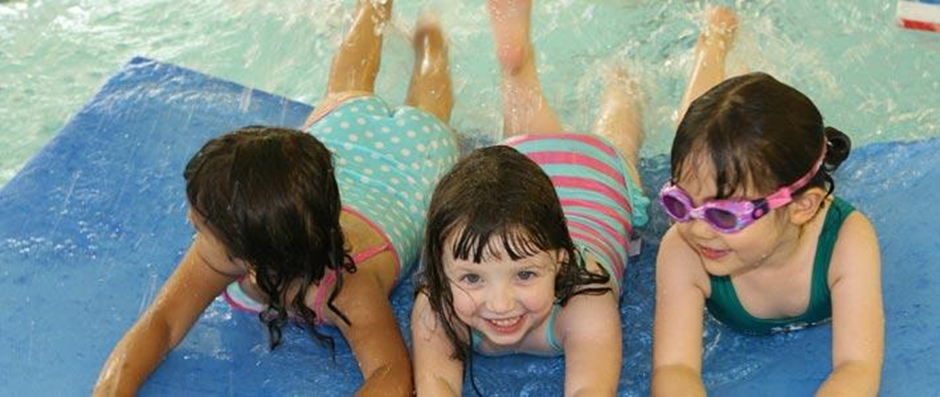
The paramount lesson of the water is respect. Even a shallow pool reminds us that as much as we can feel at home in the water, we need to adapt to this element to float and breathe. Babies encouraged to move freely and surface to breathe at their own pace will not be foolhardy in water because they have experienced their limitations directly without the false security of buoyancy aids. Gentle ways are conducive to respect, in contrast with drown proofing methods that induce the perception that water is to be feared and dominated. Correcting faulty body balance developed from this attitude to water is hard work, which is best avoided.
Personally, I love technique, achievement, and excellence in performance. The radiant face of a tot who manages to swim a few metres into his or her parent’s open arms is a great joy for me. But getting a timid baby to jump from the pool wall without holding a parent’s little finger can also be a triumph. Helping parents to unlock their babies’ potential in an active, body-based dialogue with them in water, with total acceptance, is magical. Let’s not miss out by dumbing down these brainy creatures by pretending to control them when they can best unlock their parents’ teaching skills, and our potential as swimming teachers, through heartfelt communication and movement together in water.
The Birthlight Course
The Birthlight Advanced course offers further techniques and moves that liberate parents from drown proofing babies or teaching them to swim while making these goals achievable.
Francoise freedman on the birthlight baby swimming
The STA parent and child course derived from Birthlight has touched many people’s lives and it has set up a happy foundation for early swimming and water safety skills in the many parts of the world. As baby swim schools and trainings have proliferated, babies who swim independently still make news but most parents have realised that their time in the pool with little ones has a special quality that no land-based activity can equal. The Birthlight Advanced course offers further techniques and moves that liberate parents from drown proofing babies or teaching them to swim while making these goals achievable. For Amazon rainforest people, swimming is an essential skill that is transferred in two stages and two forms: first, babies and toddlers enjoy being moved in shallow water around their parents at bath time and this has been the inspiration of the ‘relaxed hold’ practices we teach. Then children rather than parents are put in charge of getting little ones to independent swimming. Children are mostly patient and responsible but also very direct using dynamic modelling and minimal support that their younger siblings enjoy and respond to. Watching them has been an inspiration for the Birthlight moves to facilitate transitions from holds to independent swimming.
Françoise Freedman
Birthlight Baby Swimming Course
Starts 20th July 2022 with Françoise Freedman